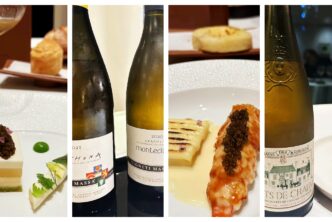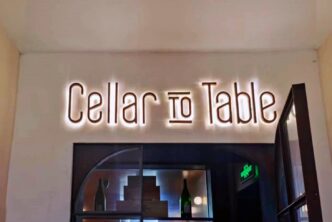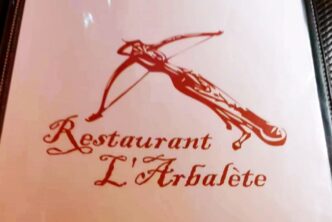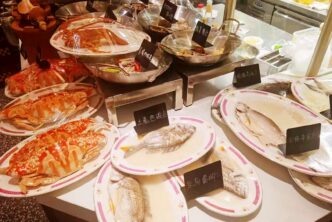Enoteca Buccone
Via di Ripetta, 19/20
00186 Rome, Italy
Tel. +39 06 361 2154

The dishes
Pizza e mortadella (Roman white pizza and mortadella)
Peperoni e patate (bell peppers and potatoes)
Uovo sodo, maionese e giardiniera (mayo boiled eggs with pickled vegetables)
Carpaccio di Chianina e parmigiano vacche rosse trenta mesi (Chianina beef carpaccio with 30-month old Parmigiano Reggiano made with milk from the famous red cows of Emilia Romagna)
Crostini con salciccia e cime di rapa (grilled bread with sausages and turnip tops)
Girello di vitella con salsa tonnata (veal filet with tuna sauce)
Biscotti (cookies)
The wines
Giorgio Colutta 2022 Ribolla Gialla Friuli Colli Orientali 92
Sirch 2022 Friulano Friuli Colli Orientali 87
La Colombera 2020 Timorasso Derthona 91
Podere Colla’s 2018 Barolo Dardi Le Rose 93
Domenico Clerico 2019 Barolo del Comune di Monforte d’Alba 92

Enoteca Buccone is one of Rome’s and Italy’s historic wine bars. I began frequenting it back in the early 1980s as an adolescent getting seriously started in the world of wine when I used to live in the Eternal City and was frequenting every wine shop (and I do mean every wine shop: being a student at the time, every penny, er, lira counted, and so I was very much into checking and comparing bottle prices in as many different establishments as possible) I could get to. Given Buccone’s dream location in the heart of downtown Rome, a five-minute walk from piazza del Popolo and the Caravaggio artworks of Santa Maria del Popolo, you know I was there as often as possible.
Anybody who knows anything about Rome and its wine scene, knows that with very few exceptions, the modern rebirth of wine culture in Rome took place in the early 1980s through the enoteche Buccone, Trimani, and Roffi Isabelli; the last of these is no longer extant and the only one of the three that was not in some way related to the Trimani-Buccone-Bulzoni family web. As much as it may surprise you to read this today, back in 1980 less than five percent of the Roman and Italian population knew anything about Barolo’s crus or that an Auslese wine is usually sweeter than a Spatlese wine (almost all Italian wine journalists of the time included); and when wine knowledge finally did become a bit more evolved than it was back in those dark ages, it remained mostly stuck in a very Italian gear. For example, I remember Paolo Trimani telling me one day in the mid-1980s that he could sell all the Chardonnay wine made by Gaja, but he had real problems trying to move his Puligny-Montrachet and Meursault wines (because nobody knew anything about them). How things have changed since then! And if they did change, it was also because of the Enoteca Buccone and its sibling wine-watering holes.

Opened in 1969, Enoteca Buccone was born when Domenico Buccone and his wife Maddalena bought the pre-existing wine shop previously owned and run by Romolo and Virginia Zecca. In fact, wine and wine sales had already been a part of this location long before then, at least since the mid-eighteenth century: the shop is part of the splendid fifteenth century Palazzo Cherubini. Situated on the very pretty via di Ripetta, this spot has always represented an ideal connection between the noble palaces of via del Corso and the somewhat more rustic but bubbly everyday life of Rome’s fluvial port area. In other words, the denizens of Rome have been coming to Buccone and all the wine establishments that preceded it for centuries.

The Buccone saga allows me to point out the close ties that exist between famous Roman families, owners of what have arguably always been the city’s most important wine shops. In fact, Maddalena Buccone was born in Trimani, the second born of Paolo and Iolanda Trimani; she was therefore the sister of Marco Trimani, owner of the Enoteca Trimani (not so arguably Rome’s oldest and most famous wine shop). At the same time, Domenico Buccone was a cousin of Sergio Bulzoni, owner of the Enoteca Bulzoni in the now very chic Parioli district of Rome (how times change: keep in mind that back in the early 1900s, the Parioli section of Rome was actually characterized as much by sheep grazing in the fields as it was by the few buildings present). In 2020, the Trimani family (that today runs not just the Enoteca Trimani but also the wildly successful Trimani Wine Bar) took over the day-to day operation of the Enoteca Buccone. And so it was that Paolo Trimani moved from his own family namesake enoteca (where his brother Francesco continues to run things while sister Carla runs the Trimani Wine Bar) and now can be met daily at the Enoteca Buccone. Paolo is one of the best and most knowledgeable Italian wine tasters I know; his input is well-worth listening to, not to mention that he also has the pulse of the Italian wine scene to a far greater degree than most locals I know. It is thanks to Paolo that the Enoteca Buccone now specializes in Champagne (with one of Rome’s largest selections of French bubblies) and Italian bubblies, as well as wines made by small artisanal producers and less well-known denominations. Clearly, famous names are not missing, so if you want something by Quintarelli or Biondi-Santi you’ll have no trouble finding what your heart desires. Buccone’s motto is more or less “at the disposal of our clients” and they are happy to send wines in just about every country it is legal to do so should the buyer wish to buy more than he or she could carry onto a plane. Otherwise, wine lovers can sit at one of the seventeen granite-top tables and try as many as fifty different wines by the glass. Service, which can be harried at times given how popular and packed the place always is, is active from ten in the morning to ten at night, meaning that as far as Rome watering holes go this is one where fluids never run dry. The drinking possibilities are accompanied by a menu that, appropriately enough for a watering hole, makes grazing easily. The food is clearly of a Roman cuisine derivation, with bitter greens, bread, peppers, dry cookies, and sausages everywhere on the menu. The “hands down winner” dish is the pizza e mortadella, warm rectangles of Roman white pizza slathered with high-quality mortadella; but the peperoni e patate (bell peppers and potatoes), but the choices run from oysters (Gillardeau, Tia Maraa, Ancelin), hummus, mayo boiled eggs with giardiniera (pickled vegetables), Chianina beef carpaccio with 30-month old Parmigiano Reggiano (made with milk from the famous red cows of Emilia Romagna), grilled bread with sausages and turnip tops, veal filet with tuna sauce, potato omelette with bacon and much more, including cheesecake and chocolate salami amongst the desserts. The menu was deliberately chosen not to emulate that of a restaurant, but rather to provide hearty, soulful bites that would pair well with the over fifty wines on tap by the glass and any other bottle you might decide to buy from the shelves that surround you and drink right there at the table.

The wines I chose on my latest evening at Enoteca Buccone were from all over the country and from some very “in” producers, some better-known than others. The Giorgio Colutta 2022 Ribolla Gialla Friuli Colli Orientali is just lip-smackingly delicious, and exactly everything a Ribolla Gialla wine should deliver: bright and vibrant, with tangerine and fresh citrus aromas and flvopurs coupled to white flowers and subtle hints of saffron. It makes an excellent aperitif, but stands up to many of the lighter-styled dishes on the menu as well (besides being the best match for the oysters). By contrast, the Sirch 2022 Friulano Friuli Colli Orientali was a major disappointment: I have always been abig fan of this winery and its wines, but I frankly don’t remember a Friulano from Sirch in the many years I have been following this winery that so tasted of in-your-face, frankly caricatural aromas and flavours of bubble gum, passion fruit and lime. I have no idea if industrial yeasts were used or not, but these aromas and flavours are found in a litany of white wines made all over the world. Don’t misunderstand me: this Friulano is not a bad wine per se, but there’s really no reason to go looking for such descriptors in a wine made in a specific wine denomination of Italy. Stick with Sirch’s usually reliable Ribolla Gialla (I have always thought the Ribolla Gialla to be this winery’s best wine) for what will undoubtedly prove a much better wine experience. The La Colombera 2020 Timorasso Derthona is a classic, and offers insight as to why this grape is such a favourite of somm liers (though in my experience the public at large isn’t quite so smitten). Still, this beauty from La Colombera is a benchmark for the variety, so don’t miss out on it. Podere Colla’s 2018 Barolo Dardi Le Rose is another classic, and one of the better wines made in the difficult 2018 vintage by an old master of the Nebbiolo variety. Red cherry, camphor, licorice, and minerals are lifted by hints of violet and rose for what is a very enjoyable glass of Barolo. Slightly riper and warmer in style, the Domenico Clerico 2019 Barolo del Comune di Monforte d’Alba offers a fleshier mouthfeel and a more mouth-filling experience. More modern in its ampler, fruit-forward personality, it offers an interesting contrast with the more reticent traditionally made Barolo by Podere Colla, though each wine has its merits and each will have many, many fans. (I also point out the comparison is slightly unfair, given that the Poderi Colla wine is made with grapes sourced in one of Barolo’s greatest crus, Bussia’s Dardi sub-region, while the Clerico is more of an entry-level Barolo made from grapes grown within the Monforte territory.)

What else is there left for me to say? Well, maybe that these last two tipples were the best possible way to call it a night, bidding farewell to old friends from Rome I hadn’t seen in five years or so (much thanks Covid, and good riddance to you) and other friends from NYC whom I had seen at least once in the last five years (in Rome, because they had come to stay in Rome for a few months). Old friends from NYC, Rome and Shanghai meeting in a wine bar in Rome: in a global world where we can now all happily travel once again, it is nice to know I shall be seeing all of them again soon enough (certainly before five-years have elapsed once again), either in Rome or elsewhere. At the same time, I thanks my lucky stars for the existence of a highly local place such as Enoteca Buccone.


 中文
中文



